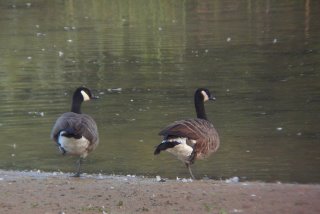A family day with good birding? You bet. First of all there were hundreds of House Martins, Sand Martins and Swallows. A Sparrowhawk flew right across the water and a Kestrel patrolled the fields at Draycote Bank.

Then at Hensborough Bank we found a small group of waders - two Lapwing, three juvenile Ringed Plover, and two initially unidentified waders. I studied them for some time, thinking first of Dunlin, and then, when I found no evidence of black markings on their bellies, considered Curlew Sandpiper (nope, not elongated enough, and no pale supercilium). Finally, seeing white stripes on the back, I went for Little Stint.
Wrong! A quick posting of some photos on Birdforum allowed several wader experts to help put me right - these were in fact juvenile Dunlin. No shame in making a mistake, only in failing to find out why. I am now settling down with a beer, my Collins fieldguide and a grim determination not to make the same mistake again. Cheers.
(Conclusion - (i) I got carried away with white stripes on the back of the birds, and forgot to stay focused on basic form and size; (ii) Collins is a good fieldguide; (iii) London Pride is an exceptionally good beer).












